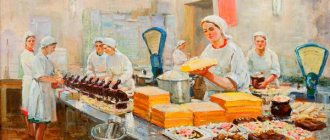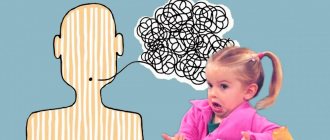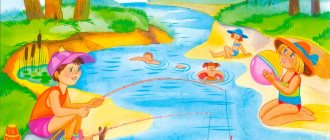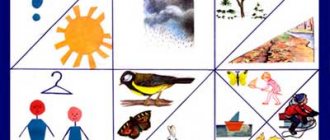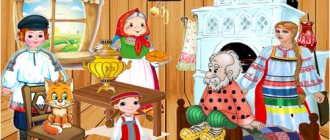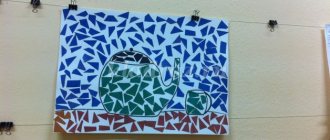Progress of the lesson:
Didactic game “Wonderful bag”
Children take doll furniture out of the bag and name it. Chair, bed, sofa, armchair, table, wardrobe - all this can be called in one word - furniture. Look around, what kind of furniture is in our room?
Didactic game “Run to the piece of furniture that I will name”
The teacher names a piece of furniture, and the children find and run up to the named piece of furniture.
Take geometric shapes and lay them out in a large chair on the diagram.
What shape did you use to make the back of the chair? From the square. What shape did they make the seat? From the oval. What shapes were the armrests made from? From circles. How many laps did you use? Two circles. Now lay out a small chair.
Didactic game “Place the nesting dolls in chairs”
Place one nesting doll on a small chair, and three nesting dolls on a large chair.
Didactic game “Arrange the sofa cushions”
These new sofas need cushions. Choose two pillows of a suitable shape for each sofa.
Didactic exercise “Find the extra object”
Take a look at the picture. It shows furniture, but one thing is not furniture. What's not furniture in the picture? Bear. It is a toy.
Dynamic pause “We need to rest”
Children move to the music according to the text.
Application “Table and stools”
We bought a new table and stools for the kitchen. What color is the table? Yellow. Show me a blue stool, a green one, a red one. Glue the seats to the stools and the top to the table. Just choose them correctly: on a blue stool - a blue seat, on a red stool - a red seat, on a green stool - a green seat, and on a yellow table - a yellow tabletop.
Game with clothespins "Chair back"
Use clothespins to make the back of a chair.
Didactic exercise “Paired pictures”
Children are given pictures depicting different pieces of furniture and asked to name this item. And then find a paired picture with exactly the same object.
Didactic game "Chest of drawers"
There are chests of drawers in front of you. Count them. How many chests of drawers? Three chests of drawers. Is it possible to say? That they are the same? No they are different. Show me the smallest chest of drawers. How many drawers does he have? One drawer. Show me the middle chest of drawers. How many drawers does he have? Two drawers. Show me the biggest chest of drawers. How many drawers does he have? Three drawers. What color is the large, small, medium chest of drawers? Look in the top drawer of the middle dresser. What's in it? Button. Place the button in the bottom drawer. And put three buttons in the top drawer of the middle chest of drawers.
Construction from building materials “Chair, table, bed”
Chair: place a brick vertically on the cube. Place a matryoshka doll on a chair. Table: Place a brick on top of the cube. Place small dishes on the table. Bed: Place bricks placed on edge to the edges of the block. Put the nesting doll to sleep.
Didactic game “Make the beds”
Place the beds in front of you. Count how many there are? Three beds. Same beds? No different. Show a large bed, a medium one, a small one. Now take the bedspreads, there are as many of them as there are beds - three. Choose the right size bedspread for each bed.
Children use their fingers to paint the picture of the sofa.
Didactic game “Put things in their places”
You have a closet and a shelf. Here are the scattered things. Clothes should be put in the closet and toys should be put on the shelf.
Furniture is made from wood. Look at these pieces of wood. To make a table, you need to cut down a tree.
Dynamic pause “Joiners”
Children perform imitation movements according to the text as shown by the teacher.
We chopped, we chopped, so that we could have logs. We sawed, we sawed - we got planks from the logs. We planed, we planed - The boards became smooth. We stacked them in a row and nailed them down with a hammer. We'll paint everything later. The result is a new table.
But if you just cut down trees, there will be no trees left. Therefore, it is necessary to plant new trees instead of those that were cut down.
Bas-relief sculpture “Tree”
Children tear off pieces of green plasticine and stick them to a picture of a tree without leaves.
Finger gymnastics “Nails”
Bom, bom, bom, bom, We hit the nails with a hammer. The nails are not driven in, they are only bent.
One hand is a “hammer” (clenched fist). The second hand is “nails” (open palm with fingers spread). The hammer-cam knocks on each nail-finger, which bends after impact.
So we need to take pliers, we will hammer in nails. I pulled, pulled, pulled, I straightened all the nails.
The nail fingers are all bent. The fingers of the other hand are pliers (the thumb and index fingers close and open). Using pliers, we alternately pull and straighten all the nail fingers.
Find a place for every button in your kitchen cabinet. Be careful to place large buttons on large circles and small buttons on small circles.
Didactic game “What’s missing?”
Pieces of doll furniture are displayed in front of the children. Then one object is removed, and the children must name which object is missing.
Dynamic pause “Lots of furniture in the apartment”
One, two, three, four, Lots of furniture in the apartment. (Walking in a circle, holding hands)
We will hang a shirt in the closet, (Spread your arms to the sides - open the doors)
And we’ll put a cup in the buffet (Stretch your hand forward)
To rest our legs, let's sit on a chair for a little while. (To squat)
And when we were fast asleep, we lay on the bed. (Lie on the carpet, hands under your cheeks)
And then the cat and I sat at the table. They drank tea and jam together. (Sit at the table)
Lots of furniture in the apartment!
Drawing with stamps and cutting with scissors “New blanket for the sofa”
Children leave prints by applying stamps along the entire plane of the bedspread, then cut the fringe edges with scissors.
Didactic game “Give me a word”
The teacher makes a riddle and shows a picture of the answer, and the children must say the answer word out loud.
If Fedya wants to sleep, He lies down on... BED
Misha entered the room and put the juice on... TABLE
Dasha fluttered into the room, took a bag and an umbrella from... A CHAIR
I took out Ivan’s new book from under... THE SOFA
Yulia Toshman
Methodological development for speech development for children 4–5 years old on the topic “Furniture”
Methodological development for speech development for children 4-5
“
Furniture ”
.
Yulia Toshman
Methodological development for speech development
“
Furniture ”
.
Methodological development
.
Educational area: speech development
.
Explanatory note: Methodological development compiled for children
4-5 years in accordance with the age characteristics
of children
, does not
contradict
educational standards and ensures the integrity of the educational process.
Purpose of development
:
development of speech hearing
, memory, coherent
speech
.
Development of fine motor skills of the hands
, coordination
of speech with movement
.
Develop the ability to care for furniture
and treat it with care.
Equipment: toy furniture
, object pictures,
cut-out pictures “
Furniture ”
, counting sticks for construction, a set of basic geometric shapes, a sensory-tactile set for each child
Thematic selection of games and exercises for young children, topic: “Furniture”
Goals:
Expand children's knowledge about furniture. Activate children's vocabulary on this topic. Form stable ideas about color, size, quantity, shape. Continue to teach children to count to three, navigate in space, and understand the meaning of the concepts “upper” and “lower.” Practice finger painting and stamping, sculpting, gluing. Develop thinking, memory, fine motor skills, coordination of movements. Coordination of words and movements.
Equipment:
A wonderful bag with pieces of toy furniture. Pieces of wood. Pictures depicting pieces of furniture (bed, sofa, armchair, table, chair) and carpenter. Clothespins, a silhouette image of a backless chair cut out of thick cardboard. A picture of sofas with white empty spaces in the form of geometric shapes in place of sofa cushions, cut out sofa cushions to match the shape. A background picture depicting a table without a tabletop and stools without seats; seats and tabletop cut out of colored paper; glue. A picture depicting three pieces of furniture and one toy - a bear. Paired pictures of furniture. Background picture with the image of a tree without leaves, green plasticine. Finger paints, coloring picture with a picture of a sofa. Cardboard beds in three sizes, pieces of fabric-bedspreads corresponding to the size of the beds. A schematic representation of two armchairs (large and small) made of a square, an oval and two circles; these same geometric figures cut out of colored cardboard. Small figurines of nesting dolls. Doll furniture. Building materials: cubes, bricks, whetstones. Colored silhouette pictures of clothes and toys, images of shelves and wardrobes. Sheets of paper in the form of a blanket, stamps, scissors. Dressers glued together from matchboxes with one, two and three drawers; buttons. Buttons, a picture of a kitchen cabinet with circles corresponding to the color and size of the buttons, in the form of handles and utensils. Audio recordings: “We need to rest”, “Tuki-tok”.
